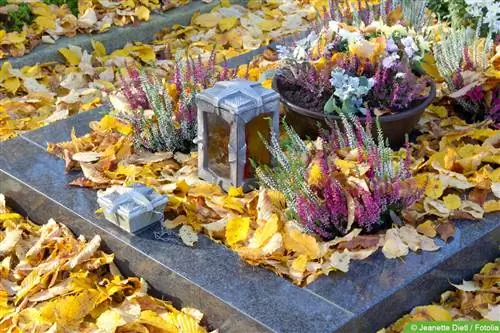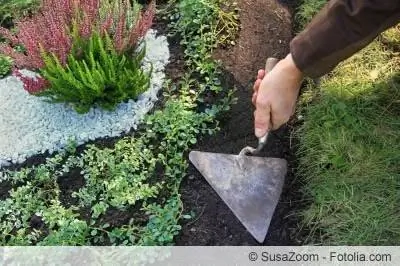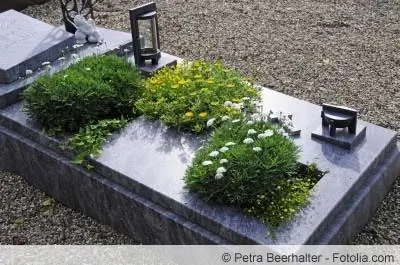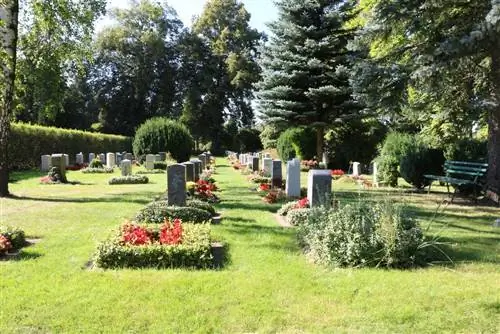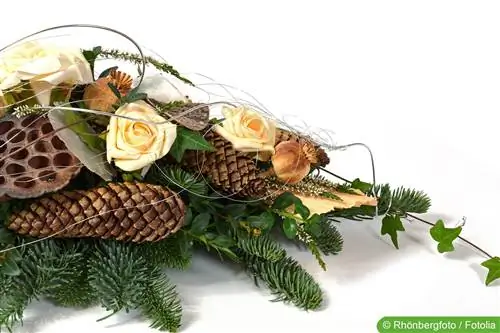- Author admin [email protected].
- Public 2023-12-17 03:39.
- Last modified 2025-06-01 06:48.
Grave planting in summer needs to be carefully thought out, as high heat and little time for watering quickly lead to damage to the plants and thus to an unsightly appearance. With these suggestions and ideas for cemetery planting, you don't have to miss out on the splendor of flowers and decorative combinations.
The floral design of the final resting place presents some challenges, especially in summer. Extreme temperatures and a lack of precipitation are problematic for grave planting, especially in sunny locations, and increase the amount of care required for the plants immensely. However, only if drought tolerance is not taken into account when choosing. If you plan in advance and consider the following ideas for cemetery planting in summer, you don't have to water every day to ensure lasting and dignified beauty, even in the blazing sun.
Selection criteria
While ground cover and frame plants have to be easy to care for and as robust as possible all year round, the main thing when it comes to grave planting in summer is that it can easily survive high heat and dry phases. This is especially the case when the final resting place cannot be visited every day and frequent watering is therefore difficult. In addition, some other criteria should be taken into account when selecting grave planting. These include:
- Höh
- Spread through runners and self-seeding
- Flowering time and duration
- General care effort and any necessary trimmings
- Demands on the location and substrate
The most beautiful flowering plant is simply of no use if it leaves all of its shoots hanging on the second hot day of summer or if it grows far too much over the head of all the other plants on the grave. In addition, a strong spread can disturb the ground cover or cause unnecessary effort in the future, as the unwanted foreign plants have to be removed repeatedly. The characteristics of the selected plants as well as some points of the overall design are therefore crucial.
Design ideas and practical tips
Since the grave planting in summer is the part of the rotating planting, the exchange should be made easy. To ensure that it remains easy to care for, we have put together the following practical design ideas and tips for grave design:
- Seasonal and therefore also summer grave plants should be placed in dug, deep or bottomless bowls. This means that the roots cannot spread too far but can still rely on reserves in the soil. In addition, the change is easier, watering can be more targeted and the roots of the ground cover do not become competition.
- Use one or three planters depending on the size of the resting place. An odd number and subtle asymmetry visually enlarge the area. Round vessels fit in more harmoniously than square ones.
- For summer grave planting, combine several colors and two to three plants of different heights. Such combinations visually loosen up and are still stylish. If only one type of plant is used, an impression that is too severe can quickly arise.
- In summer, choose plants that require very little water but still bloom for a long time. Thick-fleshed or Mediterranean plants are particularly suitable for this and reduce the effort without skimping on the flowers and beauty.
- Pay attention to the location conditions, especially when it comes to the necessary lighting conditions. Shade or full sun - some plants thrive in both extremes without any problems, while other plants only show their beauty in very specific conditions. So it's worth choosing grave plants for sunny and shady locations.
- Apply evaporation protection. To further reduce water requirements, evaporation protection should be applied around the grave planting. Mulch is ideal for many plants. But if you don't find this visually appealing, you can also use gravel or small stones - for example in white.
- Use unusual ground cover.
Ivy is the classic choice for grave planting, but if you use more eye-catching ground cover instead, you can make summer decoration easier. Recommended are:
- Goose cress
- honeysuckle
- Evergreen
- Creeping spindle
- Partridgeberry
- Snow Heath
- Dwarf Germander
- Cotoneaster
These can also be combined with each other, for example in patterns. If the base is already so decorative, a few flowering accents are enough in summer.
Recommended and popular grave planting
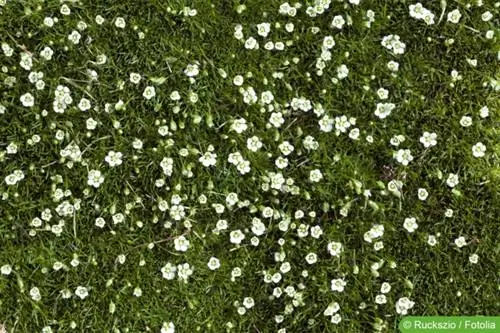
If you don't want to wade through the sheer unmanageable number of potentially suitable plants for grave planting in summer, you can find a comprehensive selection of recommended varieties here:
- Astilbene
- Carnation
- Scented Stones
- Sedum
- Kalanchoe
- Catnip
- Girl's Eye
- Mandevilla sanderi
- larkspur
- Sun Bride
- Steppe Sage
- Storksbill
- Forget-me-not
Astilbene
From white to purple, from delicately feathery and slightly overhanging to straight as an arrow - the astilbes have a wide spectrum to offer. The height also ranges from 15 to 100 centimeters, with the shorter varieties in particular being ideal for grave design.
They can also be in sunny or shady locations. However, there is one limitation here, because if astilbes or splendors, as they are also called, are in the blazing sun, they definitely need a good supply of water.
Recommended planting partners: pearl fern, glossy shield fern, Viridiflora tulips or other magnificent spars
Carnation
With a height of 25 to 60 centimeters, all varieties of bearded carnations are suitable for grave planting. They also offer a wide variety of colors and can be easily combined with other plants. Beard carnations are ideal for sunny locations and should be surrounded with a thick layer of mulch or gravel, then they can withstand the occasional long dry spell.
Recommended plant neighbors: roses, cherries, catnip
Scented Stones
Scented stoneweed or alyssum, as this cushion-shaped perennial is also called, requires very little care and does not need to be watered too often, even in dry conditions. Since alyssum only grows to a height of 15 centimeters, it is basically only suitable for summer grave planting as an ornamental underplant in the bowl and should be combined with taller plants.
Recommended plant neighbors: carnations, roses, steppe sage
Fat Hen
Undemanding and persistent, the fat hen is an ideal, if unusual, choice for grave planting in summer. If it is combined with early-flowering plants, it takes on the beautifying effect in late summer and autumn and does not require any care. With a height of 30 to 50 centimeters, it fits easily into bowls or pots.
Recommended plant neighbors: carnations, tulips, roses, steppe sage, catnip
Kalanchoe
Kalanchoe - better known under the name Flaming Käthchen - requires little water, but still has intense colors. Both in the leaves and in the bright flowers. Depending on the variety, Kalanchoe grows to a height of 30 to 40 centimeters and can be used alone for seasonal grave planting or combined with other flowering plants.
Recommended plant neighbors: Scented Stonewort, Fat Hen
Catnip
Few people know that catnip not only delights velvet paws, but is also a decorative perennial. There is an incredible diversity in the plant. There are several hundred varieties to choose from that reach heights of 20 to 120 centimeters and can bloom in almost all colors. Catnip also keeps some pests away and is ideal for planting in combination with roses. It hardly needs any water and blooms from May to October.
Recommended plant neighbors: roses, steppe sage
Tip:
Use varieties with grey-green foliage, as they can survive long periods of drought without damage.
Girl's Eye
The girl's eye has a wide variety of colors and different heights to offer and thrives best in sunny locations but still tolerates shade. If you clean out this grave planting every now and then, i.e. remove dried flowers or cut off some specimens that are still in bloom, you can prolong and intensify the splendor.
Recommended planting partners: bearded carnations, sweet stonewort, sun bride
Mandevilla sanderi
Mandevilla sanderi or Chilean jasmine blooms from May to October and is still undemanding. The firm and shiny leaves store water well and also provide a wonderful contrast to the intensely colored flowers. When choosing, you should pay attention to the height, as some Mandevilla sanderi can reach two meters if they are provided with a climbing aid. Due to the lush growth and abundance of flowers, it is not necessary to combine Mandevilla sanderi with other plants.
larkspur
The diverse perennial has candle-shaped inflorescences and is quite undemanding. Although it requires nutrient-rich soil, it can survive for a long time without additional watering, even in very sunny locations. If you choose one of the smaller cultivars, you don't have to worry about it falling apart if the plant was exposed to heavy rain or wind.
Recommended plant neighbors: catnip, steppe sage, cranesbill
Tip:
A cutting after the first flower stimulates a second one, which then falls in late summer.
Sun Bride
Unusual but stylish are Sonnenbraut varieties that bloom in red or orange-red. Most cultivated forms grow to a height of between 30 and 40 centimeters and are therefore an optimal size for grave planting in summer. In a sunny location, the sun bride will bloom from June to September. They don't need much care.
Recommended plant neighbors: delphinium, cranesbill
Steppe Sage
Robust, long-lasting blooms, evergreen - steppe sage is a good choice for grave planting, not just in summer. The straight and long inflorescences are particularly beautiful in combination with roses or the combination with white-flowering plants.
Recommended plant neighbors: Scented Stonewort, Girl's Eye, Catnip
Tip:
When choosing, pay attention to the height of the variety, because steppe sage can reach 70 centimeters and more.
Storksbill
Storksbill has over 400 varieties to offer, including white, pink or blue flowering, forms for full sun and shady locations. Overall, the plant is insensitive to diseases and pests, requires little water and nutrients and can even be hardy and evergreen. Depending on the variety, the cranesbill is a good choice for grave planting, even beyond the summer.
Recommended plant neighbors: catnip, delphinium, fat hen
Forget-me-not
Forget-me-not is, based on the name alone, a symbolically appropriate planting for the final resting place. Its low height, small flowers - which can be blue, white or pink - and low maintenance requirements also make it a good choice on the decorative and practical side. However, the forget-me-not is primarily suitable as an underplant. In addition, the location must not be too sunny.
Recommended plant neighbors: tulips, delphiniums, catnip, ferns, astilbe
Conclusion
If the grave planting in summer is planned according to both practical and stylish-decorative aspects, only little care and effort is required to maintain the beauty. The dignity of the final resting place can be preserved even without demanding cultures.


